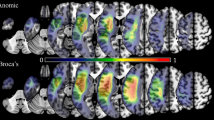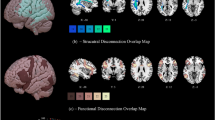Abstract
For more than a century, lesion–symptom mapping studies have yielded valuable insights into the relationships between brain and behavior, but newer imaging techniques have surpassed lesion analysis in examining functional networks. Here we used a new method—voxel-based lesion–symptom mapping (VLSM)—to analyze the relationship between tissue damage and behavior on a voxel-by-voxel basis, as in functional neuroimaging. We applied VLSM to measures of speech fluency and language comprehension in 101 left-hemisphere-damaged aphasic patients: the VLSM maps for these measures confirm the anticipated contrast between anterior and posterior areas, and they also indicate that interacting regions facilitate fluency and auditory comprehension, in agreement with findings from modern brain imaging.


Similar content being viewed by others
References
Adolphs, R., Damasio, H., Tranel, D., Cooper, G. & Damasio, A.R. J. Neurosci. 20, 2683–2690 (2000).
Dronkers, N.F. Nature 384, 159–161 (1996).
Naeser, M.A. & Hayward, R.W. Neurology 28, 545–551 (1978).
Friedrich, F.J., Egly, R., Rafal, R.D. & Beck, D. Neuropsychology 12, 193–207 (1998).
Chao, L.L. & Knight, R.T. J. Cogn. Neurosci. 10, 167–177 (1998).
Kertesz, A. Aphasia and Associated Disorders: Taxonomy, Localization and Recovery (Grune & Stratton, New York, 1979).
Petersen, S.E., Fox, P.T., Posner, M.I., Mintun, M. & Raichle, M.E. Nature 331, 585–589 (1988).
Price, C.J. J. Anat. 197, 335–359 (2000).
Maguire, E.A. et al. Proc. Natl. Acad. Sci. USA 97, 4398–4403 (2000).
Metter, E.J. et al. Arch. Neurol. 47, 1235–1238 (1990).
Knight, R.T., Scabini, D., Woods, D.L. & Clayworth, C. Electroencephalogr. Clin. Neurophysiol. 70, 499–509 (1988).
Dronkers, N.F., Wilkins, D.P., Van Valin, R.D. Jr., Redfern, B.B. & Jaeger, J.J. Cognition (in press).
Wise, R. et al. Brain 114, 1803–1817 (1991).
Blank, S.C., Scott, S.K., Murphy, K., Warburton, E. & Wise, R.J.S. Brain 125, 1829–1838 (2002).
Wise, R.J.S., Greene, J., Büchel, C. & Scott, S.K. Lancet 353, 1057–1061 (1999).
Acknowledgements
The authors thank D.P. Wilkins and C. Ludy for comments, suggestions and assistance. This work was funded by the Department of Veterans Affairs Medical Research, the National Institute of Neurological Disorders and Stroke (PO1 NS17778, NINDS 21135, PO1 NS40813) and the National Institute of Deafness and Communication Disorders (NIH/NIDCD 2 R01 DC00216).
Author information
Authors and Affiliations
Corresponding author
Ethics declarations
Competing interests
The authors declare no competing financial interests.
Supplementary information
Supplementary Fig. 1.
Methods for comparing VLSM maps. (a) A scatterplot of the correlation between fluency and comprehension t-scores, with voxels treated as subjects (r = 0.59). (b) Differences between the t-statistics for each of the tasks. The color codes are common across both panels, showing differences between t-scores. Red, voxels more important for fluency; blue, voxels more important for comprehension; green, voxels that were roughly equally relevant for both tasks. Faded colors denote lack of relevance to either measure. (JPG 55 kb)
Rights and permissions
About this article
Cite this article
Bates, E., Wilson, S., Saygin, A. et al. Voxel-based lesion–symptom mapping. Nat Neurosci 6, 448–450 (2003). https://doi.org/10.1038/nn1050
Received:
Accepted:
Published:
Issue Date:
DOI: https://doi.org/10.1038/nn1050
- Springer Nature America, Inc.
This article is cited by
-
Bayesian stroke modeling details sex biases in the white matter substrates of aphasia
Communications Biology (2023)
-
Cerebral lesions sites in neurosarcoidosis: a lesion mapping study
Journal of Neurology (2023)
-
Neural bases characterizing chronic and severe upper-limb motor deficits after brain lesion
Journal of Neural Transmission (2023)
-
Simultaneous Four Supratentorial Lesions Predict Tube Dependency Due to an Impaired Anticipatory Phase of Ingestion
Translational Stroke Research (2023)
-
Neural network mapping of gelastic behavior in children with hypothalamus hamartoma
World Journal of Pediatrics (2023)





